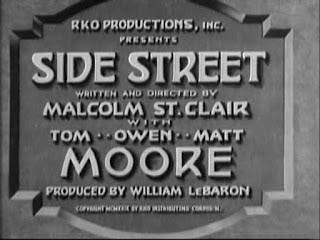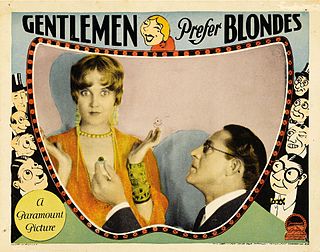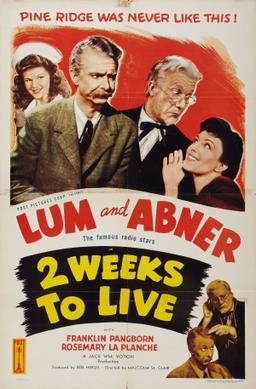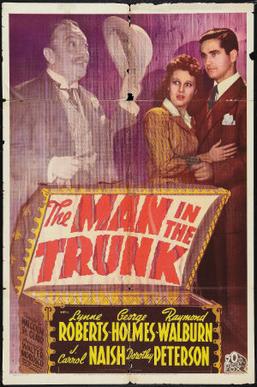
The Goat is a 1921 American two-reel silent comedy film written, and co-directed by Malcolm St. Clair and Buster Keaton and starring Keaton.

Jitterbugs is a 1943 Laurel and Hardy feature film produced by Sol M. Wurtzel and directed by Mal St.Clair.

Side Street is a 1929 American Pre-Code film featuring the only screen teaming of all three Moore Brothers, each of them major silent film stars. George Raft also makes an uncredited appearance as a professional dancer — which Raft was at the time — dancing to the song "Take a Look at Her Now", sung by June Clyde. Side Street was directed by Malcolm St. Clair with a screenplay by George O'Hara and Jane Murfin, based on a story by St. Clair, which was adapted by John Russell.

Gentlemen Prefer Blondes is a 1928 American silent comedy film directed by Mal St. Clair, co-written by Anita Loos based on her 1925 novel, and released by Paramount Pictures. No copies are known to exist, and it is now considered to be a lost film. The Broadway version Gentlemen Prefer Blondes starring Carol Channing as Lorelei Lee was mounted in 1949. It was remade into the film Gentlemen Prefer Blondes with Jane Russell as Dorothy Shaw and Marilyn Monroe as Lorelei Lee in 1953, directed by Howard Hawks.

Two Weeks to Live is a 1943 American Lum and Abner film directed by Malcolm St. Clair.

The Grand Duchess and the Waiter is a 1926 American silent romantic comedy film directed by Mal St. Clair and starring Florence Vidor and Adolphe Menjou. A “sophisticated comedy,” this Paramount production is based on a stage play by Alfred Savoir entitled La Grande-duchesse et le garcon d'etage (1924).

The Show-Off is a 1926 American silent film comedy produced by Famous Players–Lasky and distributed by Paramount Pictures, based on the play of the same name by George Kelly. Directed by Mal St. Clair, the film stars Ford Sterling, Lois Wilson and Louise Brooks.

Hollywood Cavalcade is a 1939 American film featuring Alice Faye as a young performer making her way in the early days of Hollywood, from slapstick silent pictures through the transition from silent to sound.

Breakfast at Sunrise is a 1927 silent film comedy directed by Malcolm St. Clair and produced by and starring Constance Talmadge. It was distributed by First National Pictures.

Find Your Man is a 1924 American silent action/ melodrama film starring Rin Tin Tin and June Marlowe. It was directed by Mal St. Clair who persuaded Warner Bros. to hire his friend, Darryl F. Zanuck, to write the screenplay; this began a long association between Zanuck and Rin Tin Tin. Filming took place in Klamath Falls, Oregon. This film survives. It was transferred onto 16mm film by Associated Artists Productions in the 1950s and shown on television.
Over My Dead Body is a 1942 American film directed by Malcolm St. Clair starring Milton Berle, Mary Beth Hughes and Reginald Denny.

Beau Broadway is a lost 1928 American drama silent film directed by Malcolm St. Clair and written by F. Hugh Herbert, George O'Hara and Ralph Spence. The film stars Lew Cody, Aileen Pringle, Sue Carol, Hugh Trevor and Heinie Conklin. The film was released on August 15, 1928, by Metro-Goldwyn-Mayer.

The Trouble with Wives is a 1925 American silent comedy film directed by Malcolm St. Clair, written by Sada Cowan and Howard Higgin, and starring Florence Vidor, Tom Moore, Esther Ralston, Ford Sterling, Lucy Beaumont, and Edgar Kennedy. It was released on September 28, 1925, by Paramount Pictures.

Knockout Reilly is a lost 1927 American silent drama film directed by Malcolm St. Clair and written by Pierre Collings, John W. Conway, and Kenneth Raisbeck based upon a story by Albert Payson Terhune. The film stars Richard Dix, Mary Brian, Jack Renault, Harry Gribbon, Osgood Perkins, and Lucia Backus Seger. The film was released on April 16, 1927, by Paramount Pictures.

Dangerously Yours is a 1937 American crime film directed by Malcolm St. Clair and starring Cesar Romero, Phyllis Brooks and Jane Darwell. It was a B Movie made by Twentieth Century Fox, with sets designed by the art director Lewis H. Creber.
Young as You Feel is a 1940 American comedy film directed by Malcolm St. Clair and starring Jed Prouty, Spring Byington and Joan Valerie. It was part of Twentieth Century Fox's Jones Family series of films. The film's plot was similar to that of the 1931 film Young as You Feel.

The Man in the Trunk is a 1942 American comedy film directed by Malcolm St. Clair and written by John Larkin. The film stars Lynne Roberts, George Holmes, Raymond Walburn, J. Carrol Naish, Dorothy Peterson and Eily Malyon. The film was released on September 18, 1942, by 20th Century Fox.

On Thin Ice is a 1925 American silent crime drama film directed by Mal St. Clair and starring Tom Moore, Edith Roberts, and William Russell. It was produced and distributed by the Warner Bros. and based upon a 1924 novel by Alice Ross Colver.
George Washington Jr. is a lost 1924 American silent comedy film directed by Malcolm St. Clair and written by Rex Taylor. It is based on the 1906 play George Washington Jr. by George M. Cohan. The film stars Wesley Barry, Gertrude Olmstead, Léon Bary, Heinie Conklin, Otis Harlan, and William Courtright. The film was released by Warner Bros. on February 2, 1924.

After Business Hours is a 1925 American silent drama film directed by Malcolm St. Clair and starring Elaine Hammerstein, Lou Tellegen, and Phyllis Haver.

















